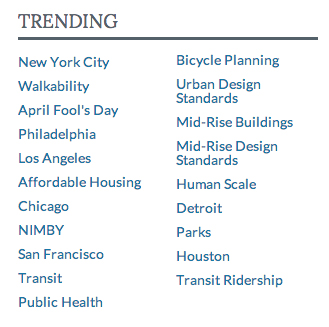We post a lot of articles here at Planetizen, and the traffic created by you, our audience, provides valuable feedback about the ideas and places of interest to the planning and urbanism community.

 With at least ten posts every day (and ten more every weekend), we at Planetizen do our best to cover a lot of geographic and intellectual territory. Thus, as we monitor which posts attract the most interest and attention, we also collect a lot of data about the ideas and places informing the always-evolving planning and urbanism conversation. Among the many articles, blog posts, and features posted on Planetizen between January 1 and March 31, 2014, here are the five most popular, according to our audience:
With at least ten posts every day (and ten more every weekend), we at Planetizen do our best to cover a lot of geographic and intellectual territory. Thus, as we monitor which posts attract the most interest and attention, we also collect a lot of data about the ideas and places informing the always-evolving planning and urbanism conversation. Among the many articles, blog posts, and features posted on Planetizen between January 1 and March 31, 2014, here are the five most popular, according to our audience:
1) The Best Planning Apps for 2014 – A blog post by Ohio State Professor of City and Regional Planning (and frequent Planetizen contributor) Jennifer Evans-Cowley shares the results of a survey of professional planners describing the mobile apps they rely on most.
2) Lessons from Don Draper (for Planners) – This post by Georgia Sheridan and Amber Hawkes provides lessons for planners looking to improve their pitch skills from the Mad Men-era business of advertising. As Sheridan and Hawkes put it in the post, “As planners, our ideas are our currency. But to have value, we must learn how to sell our ideas.”
3) Mid-Rise: Density at a Human Scale – This post by Robert Freedman, former director of urban design for the city of Toronto, describes the process by which his team created mid-rise design standards to deliver mixed-use, human-scale buildings in more neighborhoods around the city.
4) 10 Lessons in More Engaging Citizen Engagement – Brent Toderian, former director of city planning for Vancouver, and Jillian Glover, communications advisor and former planning commissioner for Vancouver, describe innovative techniques for community engagement, as employed in cities and towns in the western region of Canada.
5) How Useful is Walkability: Are You Oriented to Walk? – Author and regular Planetizen blogger Steven Snell elaborates on one of the most difficult challenges facing planners today: how to measure, and subsequently enable, walkability.
Several themes common among these stories exhibit the changing nature of planning and places. Clearly, Planetizen’s readers are interested in deeper (data-enabled?), holistic understandings of their cities and towns. There is also an obvious interest in the design standards that serve as means to planning’s ends.
But the most striking trend among these posts is a clear desire for information that can help improve communication in the planning and design process. All of these articles have, at their center, a question of how those invested in the creation of the built environment (and the protection of the natural environment) can better express and share ideas. What are the best tools for gathering and disseminating information? How helpful (or merely trendy) are many of the concepts of contemporary planning and urban design?
Such questions apply to many more people than just competent professionals in the fields of planning and urban design. In fact, these are critical skills for a well-informed and productively engaged citizenry. I’m encouraged that planners and urban designers, as exemplified by our audience’s interest in these articles, are continuing to look for new and better ways to communicate. And I’m optimistic that this work ethic, enhanced by new tools like the apps mentioned in Professor Evans-Cowley’s post, will yield more and better collaboration with the public.
I believe stories that cross-pollinate the professional-minded and the civic-minded are the gold standard of urbanism content. I hope you’ll continue to check in with us as we search for new and even more meaningful connections.

Planetizen Federal Action Tracker
A weekly monitor of how Trump’s orders and actions are impacting planners and planning in America.

Chicago’s Ghost Rails
Just beneath the surface of the modern city lie the remnants of its expansive early 20th-century streetcar system.

Amtrak Cutting Jobs, Funding to High-Speed Rail
The agency plans to cut 10 percent of its workforce and has confirmed it will not fund new high-speed rail projects.

Ohio Forces Data Centers to Prepay for Power
Utilities are calling on states to hold data center operators responsible for new energy demands to prevent leaving consumers on the hook for their bills.

MARTA CEO Steps Down Amid Citizenship Concerns
MARTA’s board announced Thursday that its chief, who is from Canada, is resigning due to questions about his immigration status.

Silicon Valley ‘Bike Superhighway’ Awarded $14M State Grant
A Caltrans grant brings the 10-mile Central Bikeway project connecting Santa Clara and East San Jose closer to fruition.
Urban Design for Planners 1: Software Tools
This six-course series explores essential urban design concepts using open source software and equips planners with the tools they need to participate fully in the urban design process.
Planning for Universal Design
Learn the tools for implementing Universal Design in planning regulations.
Caltrans
City of Fort Worth
Mpact (founded as Rail~Volution)
City of Camden Redevelopment Agency
City of Astoria
City of Portland
City of Laramie






























